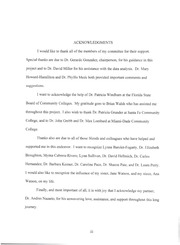
Impact of attending a college orientation class on retention, persistence, and time to degree completion of first time community college students PDF
Preview Impact of attending a college orientation class on retention, persistence, and time to degree completion of first time community college students
THEIMPACTOFATTENDINGACOLLEGEORIENTATIONCLASSON RETENTION,PERSISTENCE,ANDTIMETODEGREECOMPLETION OFFIRSTTIMECOMMUNITYCOLLEGESTUDENTS By JAMESARTHURWATSON ADISSERTATIONPRESENTEDTOTHEGRADUATESCHOOL OFTHEUNIVERSITYOFFLORIDAINPARTIALFULFILLMENT OFTHEREQUIREMENTSFORTHEDEGREEOF DOCTOROFPHILOSOPHY UNIVERSITYOFFLORIDA 1999 DEDICATION Thisprojectisdedicatedwithlovetomymother, MyraJeanWatson, andtothememoryofmylatefather, JoeAndrewsWatson. ACKNOWLEDGMENTS Iwouldliketothankallofthemembersofmycommitteefortheirsupport. SpecialthanksareduetoDr.GerardoGonzalez,chairperson,forhisguidanceinthis projectandtoDr.DavidMillerforhisassistancewiththedataanalysis. Dr.Mary Howard-HamilitonandDr.PhyllisMeekbothprovidedimportantcommentsand suggestions. IwanttoacknowledgethehelpofDr.PatriciaWindhamattheFloridaState BoardofCommunityColleges. MygratitudegoestoBrianWalshwhohasassistedme throughoutthisproject. IalsowishtothankDr.PatriciaGrunderatSantaFeCommunity College,andtoDr.JohnGrebbandDr.MaxLombardatMiami-DadeCommunity College. Thanksalsoareduetoallofthosefriendsandcolleagueswhohavehelpedand supportedmeinthisendeavor. IwanttorecognizeLynneBarolet-Fogarty,Dr.Elizabeth Broughton,MyrnaCabrera-Rivero,LynnSullivan,Dr.DavidHellmich,Dr.Carlos Hernandez,Dr.BarbaraKeener,Dr.CarolinePace,Dr.SharonPate,andDr.LauraPerry. Iwouldalsoliketorecognizetheinfluenceofmysister,JaneWatson,andmyniece.Ana Watson,onmylife. Finally,andmostimportantofall,itiswithjoythatIacknowledgemypartner, Dr.AndresNazario,forhisunwaveringlove,assistance,andsupportthroughoutthislong journey. in 1 TABLEOFCONTENTS ACKNOWLEDGMENTS iii ABSTRACT vi CHAPTERS 1 INTRODUCTION 1 TheoreticalFramework 2 StatementoftheProblem 7 NeedfortheStudy 9 PurposeoftheStudy 1 ResearchQuestions 12 DefinitionofTerms 13 OrganizationoftheStudy 13 2 REVIEWOFTHERELATEDLITERATURE 15 GeneralAttrition/RetentionStudies 15 VariablesAssociatedwithAttritionandRetention 17 CommunityCollege/4-YearInstitution 25 StudiesAddressingTinto'sVariablesofAttrition/Retention 28 IntentionandCommitment 28 ExternalObligations/FamilyandFinancial 41 Work 43 CollegeOrientationCourseStudies 46 AdjustmentandDifficulty 51 IncongruenceandIsolation 55 Summary 56 3 METHODOLOGY 57 ChapterOrganization 57 ResearchDesign 57 ResearchQuestions 5g Participants 59 ResearchProcedure 60 DataCollectionandAnalysis 60 Summary 61 IV 4 RESULTS 62 5 DISCUSSION 78 PurposeOverview 78 DiscussionofResults 78 ResearchQuestion1 78 ResearchQuestion2 79 ResearchQuestion3 79 ResearchQuestion4 80 ResearchQuestion5 80 ResearchQuestion6 81 Limitations 82 ImplicationsoftheFindingsandRecommendations 83 ImplicationsforTheory 83 ImplicationsforCollege 85 RecommendationsforFutureResearch 87 Summary 88 REFERENCES 90 BIOGRAPHICALSKETCH 106 AbstractofDissertationPresentedtotheGraduateSchool oftheUniversityofFloridainPartialFulfillmentofthe RequirementsfortheDegreeofDoctorofPhilosophy THEIMPACTOFATTENDINGACOLLEGEORIENTATIONCLASSON RETENTION,PERSISTENCE,ANDTIMETODEGREECOMPLETION OFFIRSTTIMECOMMUNITYCOLLEGESTUDENTS By JamesArthurWatson December1999 Chairperson: GerardoM.Gonzalez MajorDepartment:CounselorEducation Thepurposeofthisresearchwastostudytherelationshipbetweentakinga communitycollegeorientationclassduringthefirsttermandtheretention,persistence, andtimetodegreecompletionoffirsttimecommunitycollegestudents. Acomputersearchofthehistoricaldatabasefromfouracademicinstitutionsin Floridageneratedasampleof1,400studentswhohadenrolledforthefirsttimein college. Allparticipantswereacademicallypreparedforcollegelevelwork. The academicperformanceandpersistenceofstudentswhohadcompletedacollege orientationclassduringtheirfirsttermwascomparedtostudentsthatdidnottakea collegeorientationclassduringtheirfirsttermincollege. Measurementsweretakenat theendofthefirsttermandattheendofthefirst,second,third,andfourthyears. An analysisofvariancemodelwasutilizedtoaddresstheresearchquestions. VI Resultsofthestatisticalanalysisrevealedthatthattakingacollegeorientation classthefirsttermatacommunitycollegedoesnothaveanaffectonretention,course withdrawalpatterns,gradepointaverages,courserepetitionspatterns,andthetotal numberofcredithoursattimeofgraduation. Adiscussionofthelimitationsofthe project,implicationsofthefindings,andrecommendationsforfurtherresearchwas presented. vn CHAPTER I INTRODUCTION Studentretentioninthecommunitycollegeremainsacriticalissueinhigher education. Statisticsshowthatapproximately50%offreshmenenrolledinhigher educationdropoutbeforecompletingtheirprograms(Brawer,1996). Thisnumberhas remainedfairlystablesinceSummerskiU's(1962)earlystudyofretention. Overhalfof studentsenteringhighereducationstartinacommunitycollege. Enrollmentin communitycollegesrosefrom500,00studentsin1960toover5.5millionin1991 (Alsalam,1993). Researchersindicatedthatthedropoutratetendstobehigherfor communitycollegesthanfor4-yearcollegesanduniversities(Bean&Metzner.1985; Dougherty,1994;El-Khawas,1988;Jones,1988;Tinto,1993). CopeandHannah(1975) indicatedthatapproximately50%ofcommunitycollegestudentsremaininschoolafter theirfirstyear. Ofthosewhoremain,only50%goontocompleteanassociatedegree. Manystudiesindicatethatastudent'sdecisiontodropoutofhighereducationis usuallymadeduringthefreshmanyear(Bean,1980;Dunphy.Miller.Woodruff.& Nelson,1987;Fetters,1977;Pantages&Creedon.1977;Rootman.1972). Furthermore, themajorityofstudentsmaketheirdecisiontoleaveschoolduringthefirst6weeksofthe freshmanyear(Blanc,DeBuhr,&Martin,1983;Gardner,1989;Levitz&Noel.1989; Noel,1985;Zarveletal.,1991). Thesesequencesappeartoimplyspecificpatternsof . studentdeparture. Findingappropriatestrategiestoassistcommunitycollegestudentsin thecompletionoftheireducationalgoalscontinuestobeapriority. Collegepersistenceisaffected,toagreatdegree,bytheprocessofinteractions betweenthestudentsandtheinstitution. Asubstantialbodyofresearchsuggeststhat integrationintothesocialandacademicsystemsofthecollegeoruniversityisessentialto academicsuccessandachievement(Astin,1977,1993;Halpin,1990). Yet.howstudents achieveintegrationisnotclear(Tinto,1987). TheoreticalFramework VanGennep(1960)studiedthemovementofindividualsfrommembershipinone grouptomembershipinanother. Hisworkinsocialanthropologywasconcernedwith societalrevitalizationandsocialstabilityduringtimesofchange. Heidentifiedthree stagesinthisprocess:separation,transition,andincorporation. VanGenneptheorized thatformalritualsandceremonieshelpincorporatepersonsintoanewcommunityby providingritesofpassage. ThetheoreticalworkofTinto(1993)acknowledgesthis transitionprocessandfocusesupontheroleofstudentintegrationintocollegelife. One oftheprincipaltransitionsforcollegestudentsinvolvesmovingfromtheirhome communitytothecampuscommunity. Tintoviewscollegesanduniversitiesassmall societiesmadeupofdistinctacademicandsocialcomponents. Forstudentstobecome incorporatedandtoestablishmembershipwithinthatsociety,theyneedtobecome integratedintothesocialandacademicsystemsthatexistoncampus(Tinto,1993). Spady(1970)wasthefirsttoapplyDurkheim's(1951)theoryofcommunityand suicidetothesubjectofeducationalpersistence. BuildinguponSpady'swork,Tinto developedatheoryofstudentdeparturefromhighereducation(Tinto,1975). Durkheim suggestedthatsuicidemayresultwhenanindividualisunabletointegrateandestablish membershipwithinasociety. Tintoproposedthatthismodelisanalogoustostudent departurefromeducation. Tinto(1988)maintainedthatduringthefreshmanyear studentsmayfeelasenseofnormlessness. Hestatedthat"havinggivenupthenorms andbeliefsofpastassociationsandnotyethavingadoptedthoseappropriateto membershipinanewcommunity,theindividualisleftinastateofatleasttemporary anomie"(pp.442-443). Integrationintoacampuscommunitymayalsobemoredifficult forstudentswhosefamilies,community,and/orschoolshadverydifferentnormsand patternsofbehaviorthanthatofthenewcollege(Chapman&Pascarella.1983:Smith 1982;Tinto1986,1993). Tinto(1993)theorizedthatstudentsenteracollegeoruniversitywithvarying patternsofpersonal,familial,andacademiccharacteristicsandskills. Theseattributes helptosetboundariesofindividualattainmentandcolorthecharacterofindividual experiencewithintheinstitution. Thesepatternsincludethestudent'sinitialdisposition andintentionsregardingcollegeattendanceandhis/herpersonalgoals. Ontheindividual level,theattributesofintentionandcommitmentrepresentwhatTintoreferstoas primaryrootsofdeparture. Intentionreferstoastudent'svalueandwillingnesstowork fordegreeattainment. Researchershaveobservedthatstudentswhohavedefiniteor advanceddegreeaspirationsweremorelikelytopersistthanthosewithloweror undetermineddegreegoals(Astin1975,Lenning,Beal,&Sauer,1980;Tinto,1975,1986, 1993). Commitmentreferstoboththeindividual'seducational/occupationalgoalsandto
